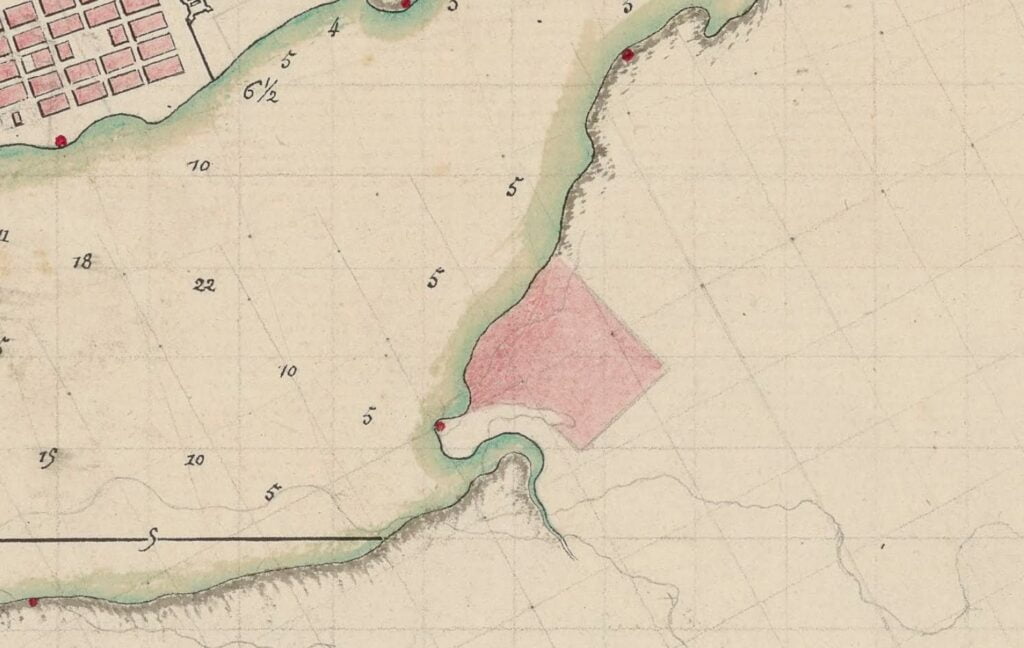
Chabert, Joseph-Bernard de. “Plan de la rade et des ports de Chibouctou” >1750. https://gallica.bnf.fr/ark:/12148/btv1b530900341/f1.item.r=chebouctou.zoom
Amicitia Crescimus

Chabert, Joseph-Bernard de. “Plan de la rade et des ports de Chibouctou” >1750. https://gallica.bnf.fr/ark:/12148/btv1b530900341/f1.item.r=chebouctou.zoom
“List of Contributors: … P. McNab, Dartmouth – barley and oats.”
“On the east side of the harbor is situated the town of Dartmouth, settled in 1750. The town is well situated, and is admirably adapted to the employment of ship-building. It is connected with the city by steamboats.”
“Prior to 1719 (at which time Annapolis was the seat of government) the management of the civil affairs of the province was vested solely in the Governor; and, in his absence, in the Lieutenant-Governor or the Commander-in-Chief. In 1719, Governor Phillips, who succeeded Mr. Nicholson, received instructions from the British Ministry to choose a Council from amongst the principal English inhabitants, and, until an Assembly could be formed, to regulate himself by the instructions of the Governor of Virginia. This Council was composed of twelve members, principally officers of the garrison and the public departments. The Governor and Council, from the necessity of the circumstances, combined both the legislative and judicial authority, which, except in so far as they were restrained by the general principles of law, was absolute in all cases. In 1749 the seat of government was transferred to Halifax, where Governor Cornwallis formed a Council somewhat similar in its functions to the one at Annapolis. This method of administration continued until after the conquest of Louisburg in 1758, when Governor Lawrence, who had before the sailing of the expedition, received an order to issue writs for the election of representatives, but which was delayed because of the unsettled state of public affairs, proceeded to constitute a House of Assembly. This Assembly was composed of 16 members, eleven of whom formed a quorum for the transaction of business. The province at this time was not divided into counties. Lunenburg township was allowed to send two representatives, and the township of Halifax four. The representatives entered upon their duties with zeal and intelligence. The most important manner which they adopted were the confirming the past proceedings of the Courts of Judicature, the establishing a form of religious worship, the granting the security of full liberty of conscience, …
The civil constitution which now existed, continued without any fundamental change, until the concession by the Crown, of the modern form of administration called “Responsible Government,” which Nova Scotia received in the year 1841. The way was in some measure prepared for this latest reform, in 1838, when two Councils were created, an Executive and a Legislative; and the deliberations of the Legislative Council were for the first time made open to the public.
The present political constitution of Nova Scotia may be briefly described as follows: The highest authority is vested in the Lieutenant Governor, who is styled His Excellency (as the Queen’s Representative.) The Lieutenant Governor of Nova Scotia is nominally subordinate to the “Governor General of British North America.” It is, however, only a distinction of rank, as the administration of the respective colonies is in no respect connected.
The Lieutenant Governor is surrounded by an Executive Council, chosen from the Legislative Council and the House of Assembly, and appointed by the Crown, who are his sworn advisers in the exercise of his administrative and legislative duties, and who are responsible to the people for the acts of his administration. Five of the members of the Executive are, in accordance with the principles of Responsible Government, heads of public departments, viz : the Attorney General, Solicitor General, Provincial Secretary, Financial Secretary and Receiver General.
The Legislative Council, which is analogous in its legislative functions to the House of Lords, consists of twenty-one members, one of whom is President. They are appointed by the Crown, upon the recommendation of the Executive, and hold their seats for life. The House of Representatives, or more frequently called the House of Assembly, consists of fifty-five members, representing counties and townships, who are elected every four years. The elective franchise is granted to every male of twenty-one years of age, who is a natural-born or naturalized subject of the Queen of Great Britain, and who has been for one year a resident of the county or township in which he votes. In its mode of procedure the House of Assembly, ss far as possible, conforms to the usages of the lower house of the British Parliament.”
London International Exhibition. Nova Scotia In 1862: Papers Relating to the Two Great Exhibitions In London of That Year .. [Halifax, N.S.?: s.n.], 1864. https://hdl.handle.net/2027/aeu.ark:/13960/t2w38br0g
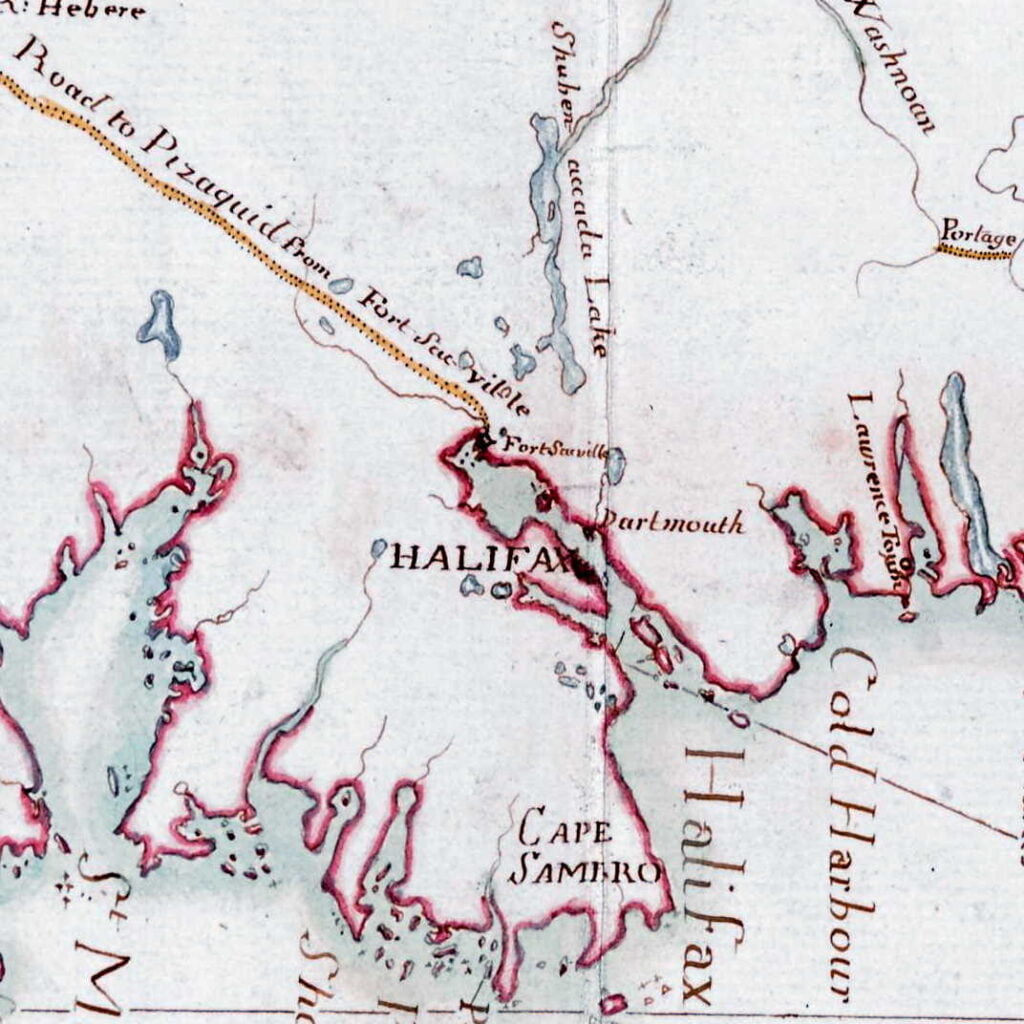
Morris, Charles. “A CHART OF THE SEA COASTS OF THE PENINSULA OF NOVA SCOTIA” 1755. https://collections.leventhalmap.org/search/commonwealth:hx11z491q

Brewse, John. “A Map of the Surveyed Parts of Nova Scotia MDCCLVI”, 1756. https://collections.leventhalmap.org/search/commonwealth:hx11z499x
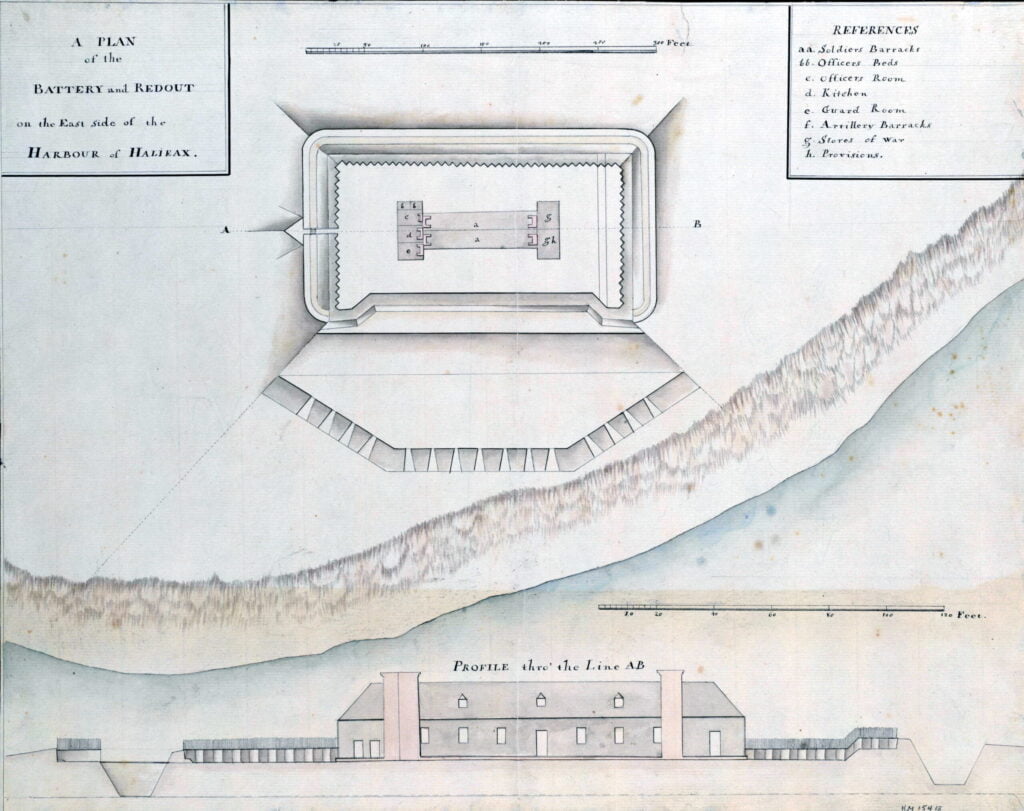
This is likely Fort Clarence, though from the shape of the shoreline and the profile of the fort itself it could also be what was once Fort Duncan, dismantled by 1808, which today would be located underneath the MacDonald bridge at the bottom of Lyle Street.
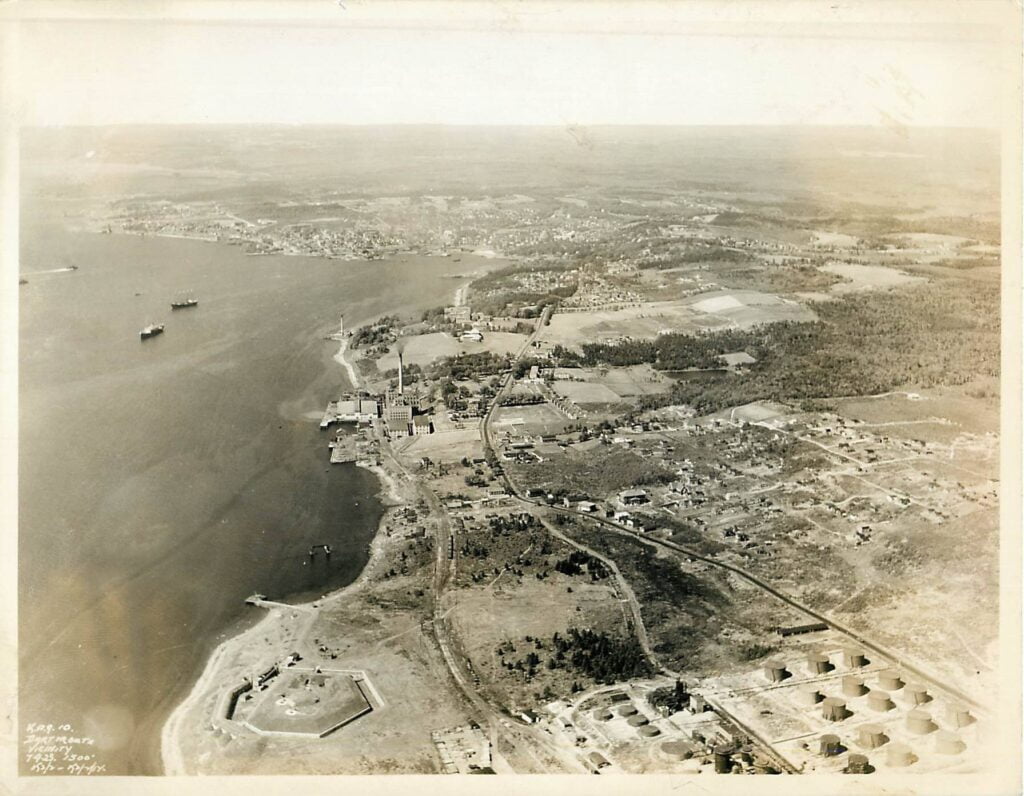

Fort Clarence at left, later the Imperoyal refinery, Fort Duncan at right.
“A plan of the battery and redout on the east side of the harbour of Halifax” >1749. https://hdl.huntington.org/digital/collection/p15150coll4/id/16120
“The [Mi’kmaq] had appeared in the neighborhood of the town for several weeks, but intelligence had been received that they had commenced hostilities, by the capture of twenty persons at Canso… On the last day of September they made an attack on the sawmill at Dartmouth, then under the charge of Major Gilman. Six of his men had been sent out to cut wood without arms. The [Mi’kmaq] laid in ambush, killed four and carried off one, and the other escaped and gave the alarm, and a detachment of rangers was sent after the [Mi’kmaq], who having overtaken them, cut off the heads of two [Mi’kmaq] and scalped one.
This affair is mentioned in a letter from a gentleman in Halifax to Boston, dated October 2nd as follows: “About seven o’clock on Saturday morning before, as several of Major Gilman’s workmen with one soldier, unarmed, were hewing sticks of timber about 200 yards from his house and mills on the east side of the harbor, they were surprised by about 40 [Mi’kmaq], who first fired two shots and then a volley upon them which killed four, two of whom they scalped, and cut off the heads of the others, the fifth is missing and is supposed to have been carried off.”
“The Governor deeming it expedient that some permanent system of judicial proceedings to answer the immediate exigencies of the Colony should be established, a committee of Council was accordingly appointed to examine the various systems in force in the old Colonies. On 13th December, Mr. Green reported that after a careful investigation, the laws of Virginia were found to be most applicable to the present situation of the province. The report was adopted. It referred principally to the judicial proceedings in the General Courts, the County Courts, and other tribunals.”
[More on the constitutional connections between Nova Scotia and Virginia: Virginia and Nova Scotia: An Historical Note, “As Near as May Be Agreeable to the Laws of this Kingdom”: Legal Birthright and Legal Baggage at Chebucto, 1749, Draught of H.M. Commission to Richard Philips to be Governor of Placentia and Cap. General and Governor in Chief of Nova Scotia or Accadie, June 19 1719 (relying on) Commission and Instructions to the Earl of Orkney for the Government of Virginia, 1715, Catalogue of books in the Nova Scotia Legislative Council Library, The First Charter of Virginia (1606)]
“In the month of August, 1750, three hundred and fifty-three settlers arrived in the ship Alderney… Those who came in the ship Alderney, were sent to the opposite side of the harbor, and commenced the town of Dartmouth, which was laid out in the autumn of that year. In December following, the first ferry was established, and John Connor appointed ferryman by order in Council.
In the Spring of the following year the [Mi’kmaq] surprised Dartmouth at night, scalped a number of settlers and carried oft several prisoners. The inhabitants, fearing an attack, had cut down the spruce trees around their settlement, which, instead of a protection, as was intended, served as a cover for the enemy. Captain Clapham and his company of Rangers were stationed on Block-house hill, and it is said remained within his block-house firing from the loop-holes, during the whole affair. The [Mi’kmaq] were said to have destroyed several dwellings, sparing neither women nor children. The light of the torches and the discharge of musketry alarmed the inhabitants of Halifax, some of whom put off to their assistance, but did not arrive in any force till after the [Mi’kmaq] had retired. The night was calm, and the cries of the settlers, and whoop of the [Mi’kmaq] were distinctly heard on the western side of the harbor. On the following morning, several bodies were brought over — the [Mi’kmaq] having carried off the scalps. Mr. Pyke, father of the late John George Pyke, Esq., many years police magistrate of Halifax, lost his life on this occasion. Those who fled to the woods were all taken prisoners but one. A court martial was called on the 14th May, to inquire into the conduct of the different commanding officers, both commissioned and non-commissioned, in permitting the village to be plundered when there were about 60 men posted there for its protection.
There was a guard house and small military post at Dartmouth from the first settlement, and a gun mounted on the point near the Saw Mill (in the cove) in 1749. One or two transports, which had been housed over during winter and store ships were anchored in the cove, under cover of this gun, and the ice kept broke around them to prevent the approach of the [Mi’kmaq]. The attempt to plant a settlement at Dartmouth, does not appear to have been at first very successful. Governor Hobson in his letter to the Board of Trade, dated 1st October, 1753, says, “At Dartmouth there is a small town well picketed in, and a detachment of troops to protect it, but there are not above five families residing in it, as there is no trade or fishing to maintain any inhabitants, and they apprehend danger from the [Mi’kmaq] in cultivating any land on the outer side of the pickets.”
There is no record of any concerted attack having been made by the [Mi’kmaq] or French on the town of Halifax.”
“German palatine settlers (arrived on the 10th of June 1751, and) they were employed at Dartmouth in picketing in the back of the town.”
“On February 3rd 1752, a public ferry was established between Halifax and Dartmouth and John Connors appointed ferryman for three years, with the exclusive privilege, and ferry regulations were also established.”
“The government mills at Dartmouth, under charge of Captain Clapham, were sold at auction in June. They were purchased by Major Gilman for $310.”
“In 1754, an order was made for permission to John Connors, to assign the Dartmouth Ferry to Henry Wynne and William Manthorne.”
January 26th 1756, the term of Henry Wynne and William Manthorne’s licenses of the Dartmouth and Halifax ferry having expired, John Rock petitioned and obtained the same on the terms of his predecessors.”
“(1757) was also memorable as the one in which Representative government was established in Nova Scotia. The subject of calling a Legislative Assembly had undergone much discussion. It had been represented by the Governor and Council, to the authorities in England, that such a step at that particular time would be fraught with much danger to the peace of the colony. Chief Justice Belcher, however, having given his opinion that the Governor and Council possessed no authority to levy taxes, and their opinion being confirmed in England, it was resolved by council on January 3rd 1757, that a representative system should be established and that twelve members should be elected by the province at large, until it could be conveniently divided into counties, and that the township of Halifax should send four members, Lunenburg two, Dartmouth one, Lawrencetown one, Annapolis Royal one, and Cumberland one, making in all twenty-two members, and the necessary regulations were also made for carrying into effect the object intended.”
“In September, 1785, a number of whalers from Nantucket came to Halifax ; three brigantines and one schooner, with crews and everything necessary for prosecuting the whale fishery, which they proposed to do under the British flag. Their families were to follow. A short time after they were joined by three brigantines and a sloop from the same place. On the twentieth of October following, the Chief Land Surveyor was directed to make return of such lands as were vacant at Dartmouth to be granted to Samuel Starbuck, Timothy Folger, and others, from Nantucket, to make settlement for the whalers. The Town of Dartmouth had been many years previously laid out in lots which had been granted or appropriated to individuals, some of whom had built houses, and others though then vacant, had been held and sold from time to time by their respective owners. Most of these lots were reported vacant by Mr. Morris, the surveyor, and seized upon by the Government, as it is said, without any proceeding of escheat, and re-granted to the Quakers from Nantucket, which caused much discontent, and questions of title arose and remained open for many years after.”
“The whale fishery was the chief subject which engaged the attention of the public during (1785). Much advantage was expected to accrue to the commerce of the place from the Quakers from Nantucket having undertaken to settle in Dartmouth. They went on prosperously for a short time, until they found the commercial regulations established in England for the Colonies were hostile to their interests, and they eventually removed, some of them, it is said, to Wales and other parts of Great Britain, where they carried on their fishery to more advantage.
A petition was presented this autumn to the Governor and Council from a number of merchants, tradesmen and other inhabitants, praying for a Charter of Incorporation for the Town of Halifax. This was the first occasion on which the subject was brought prominently before the public. It was, however, not deemed by the government ” expedient or necessary ” to comply with the prayer of the petition. The reasons are not given in the Minute of Council, which bears date 17th November, 1785. The names of the Councillors present were Richard Bulkeley, Henry Newton, Jonathan Binney, Arthur Goold, Alexander Brymer, Thomas Cochran and Charles Morris.
The functions of His Majesty’s Council at this period of our history embraced all departments of executive authority in the Colony. They were equally supreme in the control of town affairs as those of the province at large. The magistrates, though nominally the executive of the town, never acted in any matter of moment without consulting the Governor and Council. The existence of a corporate body having the sole control of town affairs would in a great measure deprive them of that supervision which they no doubt deemed, for the interest of the community, should remain in the Governor and Council.”
“Folger and Starbuck, the Quaker whalers, who settled at Dartmouth a year or two since, left (in 1792), for Milford Haven in Great Britain, where they expected to carry on their whale fishery with greater facilities than at Dartmouth.”
“…the Governor, M. Danseville, with several hundred prisoners and stores were brought to Halifax. They landed on the 20th of June (1793). Governor Danseville was placed on parole, and resided at Dartmouth for many years in the house known as Brook House, now or lately the residence of the Hon. Michael Tobin, Jr., about a couple of miles or more from Dartmouth town. The old gentleman displayed some taste in beautifying the grounds at Brook House. He built a fish pond and laid out walks among the beech and white birch groves near the house. The pond still remains, but the walks and most of the trees have long since disappeared. He remained a prisoner with an allowance from Government until the peace of 1814, when he returned to his own country a zealous royalist.”
“a poll tax had been imposed by Act of Legislature in 1791.”
“During the spring of 1796 Halifax suffered from a scarcity of provisions. The inhabitants were indebted to Messrs. Hartshorne and Tremain, whose mills at Dartmouth enabled them, through the summer, to obtain flour at a reduced price and to afford a sufficient supply for the fishery.”
“The following list of town officers appointed by the Grand Jury for the Town March 5th 1806, will be found interesting: … Edward Foster, Surveyor of highways from Dartmouth Town Plot to the Basin; Samuel Hamilton, Constable from Dartmouth Town Plot to the Basin; Jon. Tremain, Sr., William Penny, Surveyors of Highways, Dartmouth Town Plot; David Larnard, Constable, Dartmouth Town Plot; James Munn, Pound Keeper, Dartmouth Town Plot; Henry Wisdom, Surveyor of Highways from the Ferry up the Preston Road to Tanyard”
“In the autumn (of 1814) the small pox made its appearance in Dartmouth and Preston and was very fatal among the Chesapeake blacks].”
“There were two ferries (in 1815). The upper ferry was conducted by John Skerry, whose memory is still cherished by many, both in Dartmouth and Halifax, as one of the most obliging and civil men of his day. Skerry’s wharf in Dartmouth was a short distance south of the steam boat wharf (—at the foot of Ochterloney Street today). The other ferry was the property of Mr. James Creighton, known as the Lower Ferry, situate to the south of Mott’s Factory (—at the bottom of Old Ferry Road). It was conducted for Mr. Creighton by deputy and was afterwards held under lease by Joseph Findlay, the last man who ran a ferry boat with sails and oars in Halifax Harbor. These ferry boats were furnished with a lug sail and two and sometimes four oars. They were large clumsy boats and occupied some thirty or forty minutes in making the passage across the harbor. There were no regular trips at appointed hours. When the boat arrived at either side the ferryman blew his horn (a conch shell) and would not start again until he had a full freight of passengers. The sound of the conch and the cry of ”Over! Over! ” was the signal to go on board. The boats for both ferries landed at the Market Slip at Halifax.
An act of the Legislature had been obtained this session to incorporate a Steamboat Company with an exclusive privilege of the ferry between Halifax and Dartmouth for 25 years. They could not succeed in getting up a company, steam navigation being then in its infancy, and in the following year had the act amended to permit them to run a boat by horses to be called the Team-boat. This boat consisted of two boats or hulls united by a platform with a paddle between the boats. The deck was surmounted by a round house which contained a large cogwheel, arranged horizontally inside the round house, to which were attached 8 or 9 horses harnessed to iron stanchions coming down from the wheel. As the horses moved round, the wheel turned a crank which moved the paddle. It required about twenty minutes for this boat to reach Dartmouth from Halifax. It was considered an immense improvement on the old ferry boat arrangement, and the additional accommodation for cattle, carriages and horses was a great boon to the country people as well as to the citizens of Halifax, who heretofore had been compelled to employ Skerry’s scow when it was found necessary to carry cattle or carriages from one side of the harbor to the other.
The first trip of the Team-boat was made on the 8th November, 1810. The following year an outrage was committed which caused much excitement and feeling in the town. All the eight horses in the boat were stabbed by a young man named Hurst. No motive for this cruel act could be assigned, drunkenness alone appearing to be the cause. The culprit was tried for the offence and suffered a lengthy imprisonment. Mr. Skerry kept up a contest with the Company for several years, until all differences were arranged by his becoming united with the Company, and after a short time old age and a small fortune, accumulated by honest industry, removed him from the scene of his labors.
The team-boat after a year or two received an addition to her speed by the erection of a mast in the centre of the round house, on which was hoisted a square sail when the wind was fair, and afterwards a topsail above, which gave her a most picturesque appearance on the water. This addition considerably facilitated her motion and relieved the horses from their hard labor. As traffic increased several small paddle boats were added by the Company, which received the appellation of Grinders. They had paddles at the sides like a steamboat, which were moved by a crank turned by two men. In 1818 the proprietors of the old ferries petitioned the House of Assembly against the Teamboat Company suing these small boats as contrary to the privilege given them by the Act of Incorporation. It afterwards became a subject of litigation until the question was put an end to by Mr. Skerry becoming connected with the Company. Jos. Findlay continued to run his old boats from the south or lower ferry until about the year 1835.”
“During the month of February (1818), the harbor was blocked up with float ice as far down as George’s Island. Between 13th and 20th, persons crossed from Dartmouth on the ice at the Narrows.”
“By the 27th of January 1821 the ice formed a firm bridge between Halifax and Dartmouth, over which a continuous line of sleighs, teams and foot passengers might be seen on market days.”
Akins, Thomas B., 1809-1891. History of Halifax City. [Halifax, N.S.?: s.n.], 1895. https://hdl.handle.net/2027/aeu.ark:/13960/t7zk65s8s
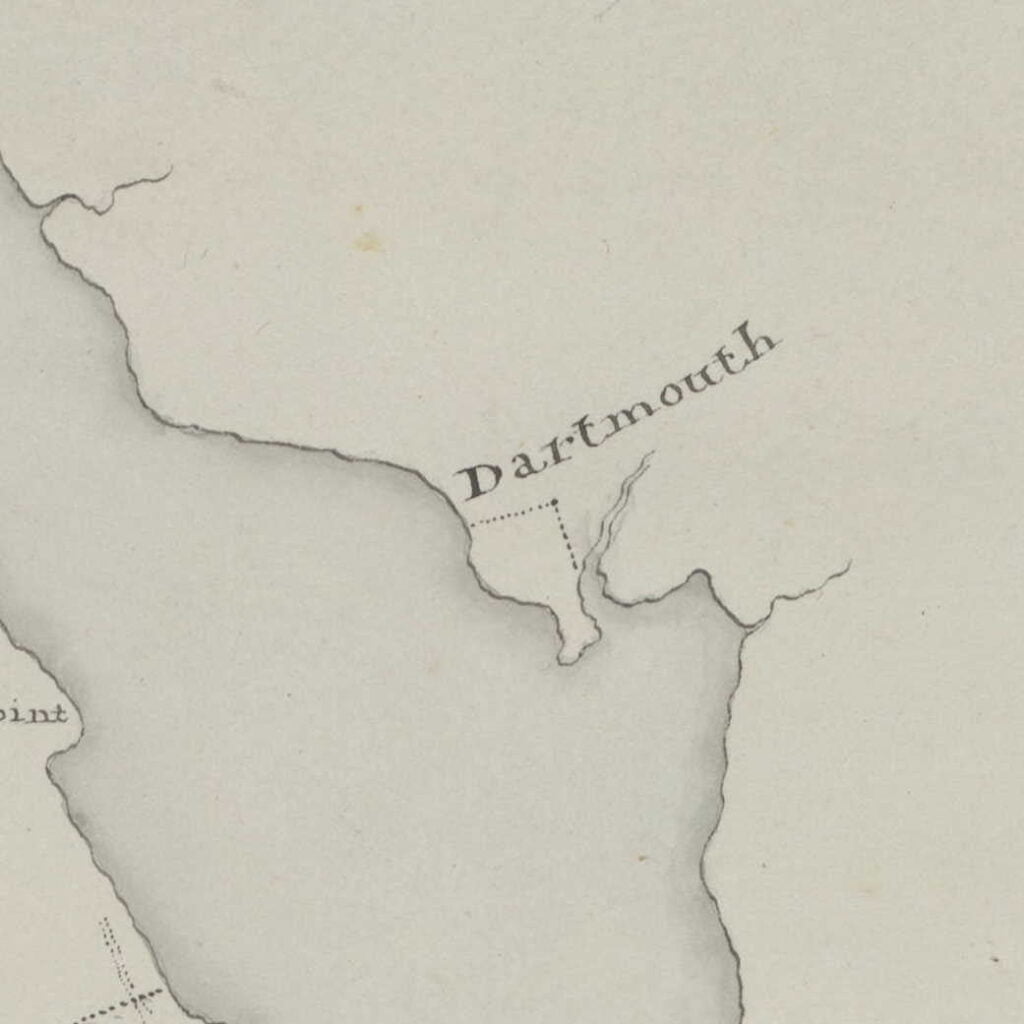
Rivez, Charles. “A map of the harbour of Halifax” >1757. https://hdl.huntington.org/digital/collection/p15150coll4/id/16195
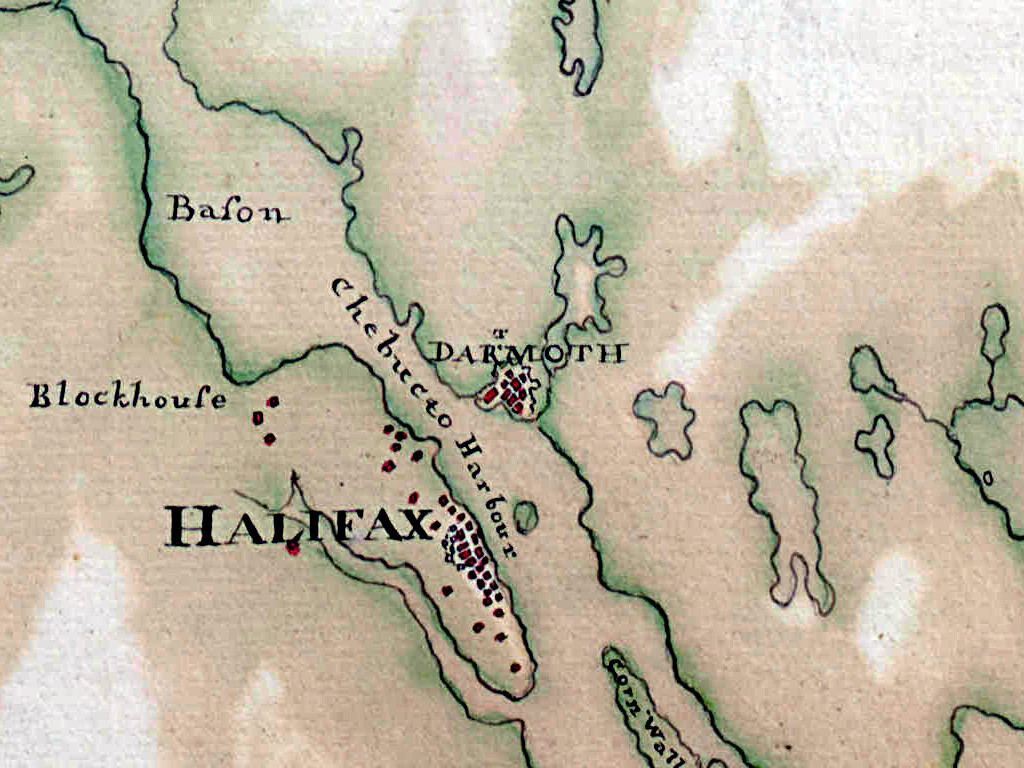
“Manuscript map copy by Samuel Holland showing the coasts around Halifax, to Lunenburg Harbour, and from Minas Basin to Forts Cumberland and Lawrence on the Bay of Fundy. Also shows the road from Fort Sackvile to Pisiguit Fort and the old Acadian villages around Bedford Bay”
Holland, Samuel. “Map of that part of Nova Scotia contained between Lunenburgh and the Bay Vert by Halifax and Pisiguit, including Cobiguit and Tatmagouch” 1755. https://hdl.huntington.org/digital/collection/p15150coll4/id/16150
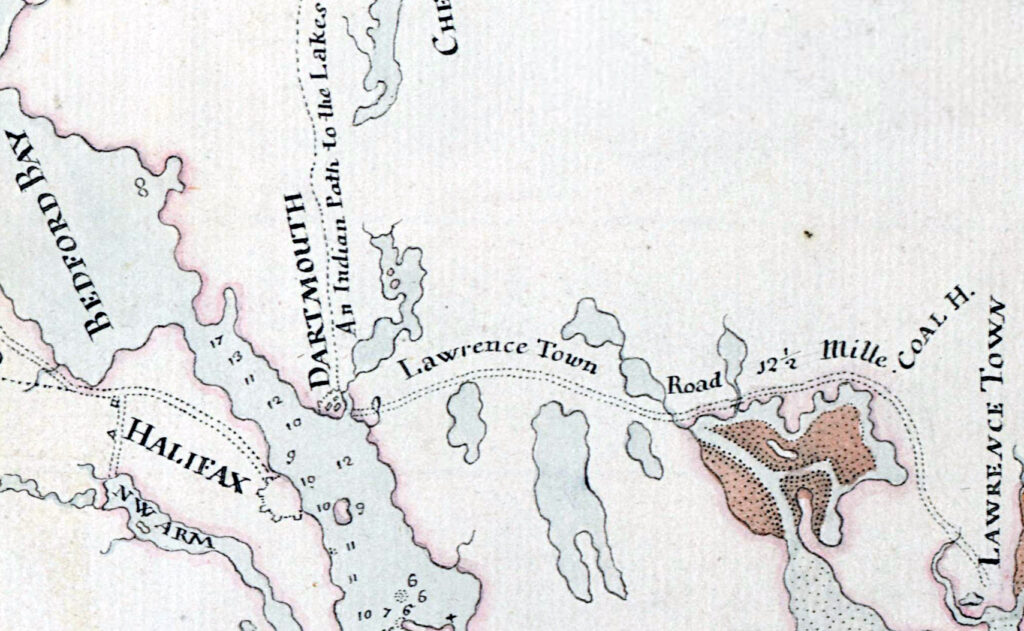
“An Indian path to the lakes by which and the River Chebenacadie they go to Quebecq”, which seems to follow what was the original path of Crichton Avenue, also noted, “Coal Harbor”.
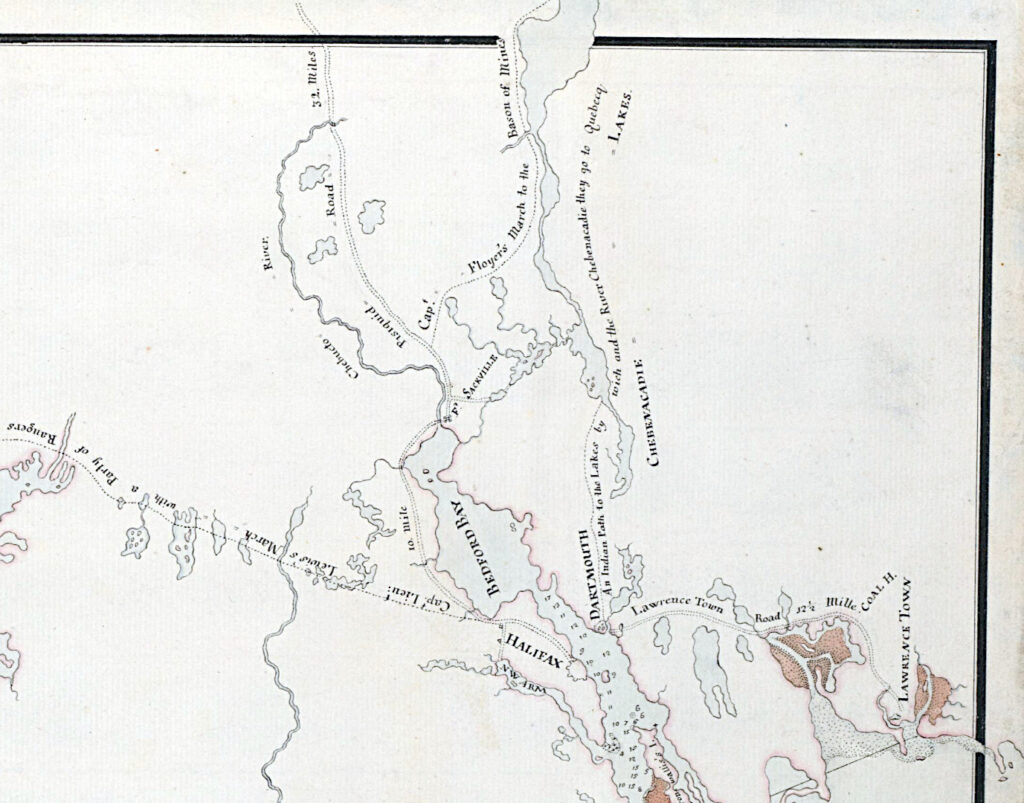
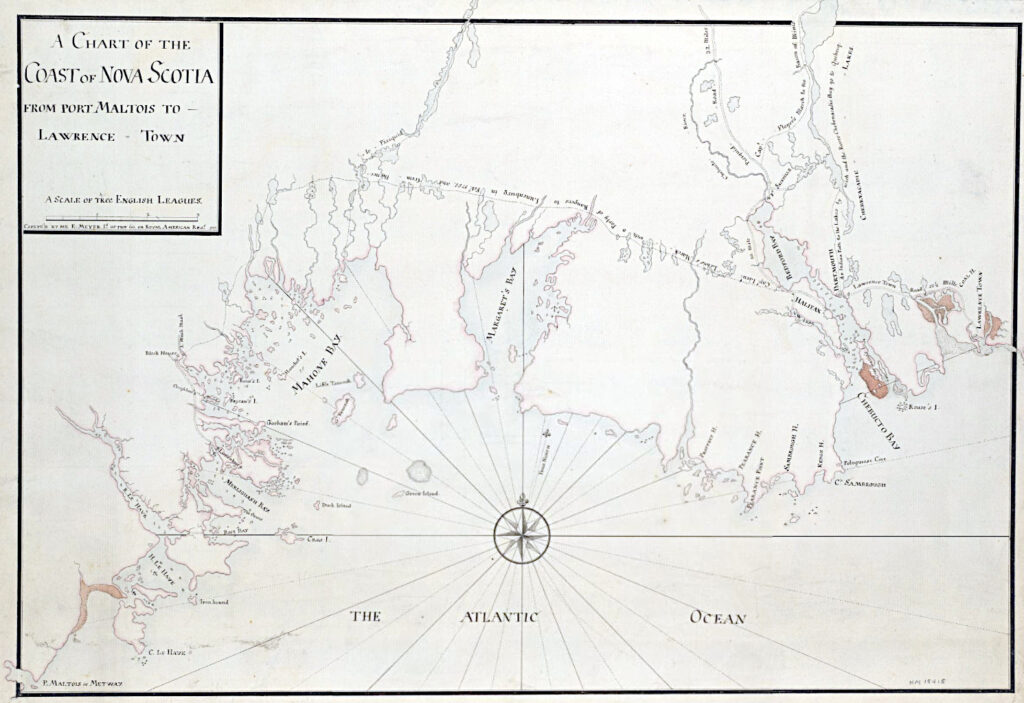
Meyer, Elias. “A chart of the coast of Nova Scotia from Port Maltois to Lawrence town [cartographic material] / Copeye’d by me E. Meyer Lt. of the 60, or Royal American Regt. 1757” https://hdl.huntington.org/digital/collection/p15150coll4/id/16135
“Rhode Islanders emigrating to Nova Scotia? How is that? …Ah Yes! They must have been a group of Tories… No! The colony of which I speak left the parent stock when all were alike loyal to the sovereign of Great Britain – indeed at just the juncture when it was the proudest boast of every New Englander that he was a British subject.
Jan. 11, 1759, Governor Lawrence sent forth from the Council Chamber at Halifax, a second proclamation:
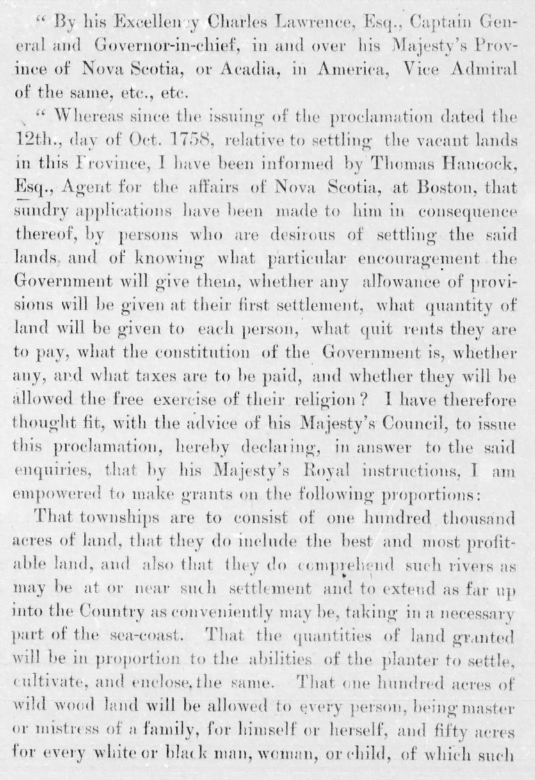
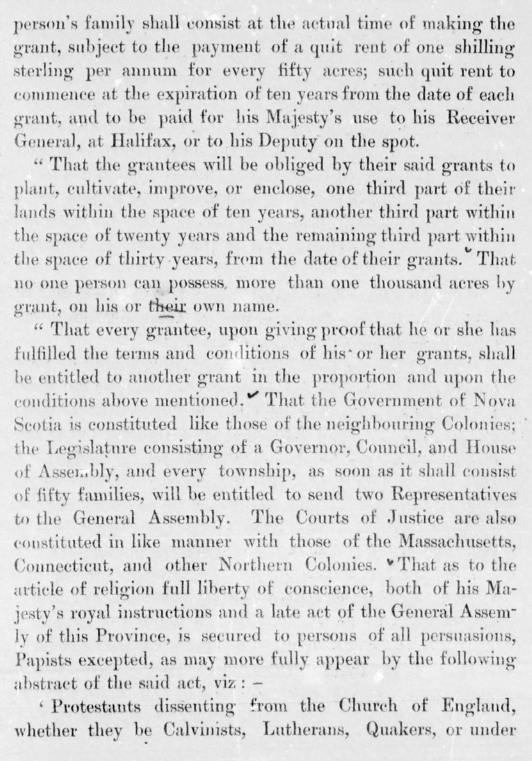
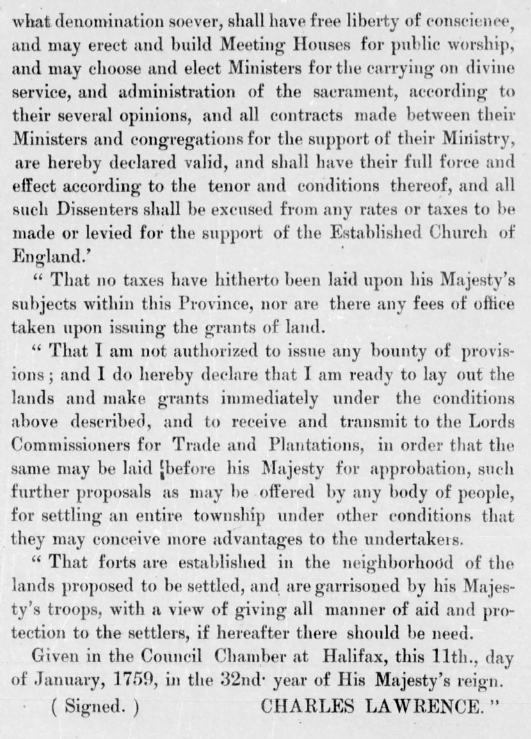
“By his Excellency Charles Lawrence, Esq., Captain General and Governor-in-chief, in and over his Majesty’s Province of Nova Scotia, or Acadia, in America, Vice Admiral of the same etc. etc.
“Whereas since the issuing of the proclamation dated the 12th., day of Oct. 1758, relative to settling the vacant lands in this Province, I have been informed by Thomas Hancock, Esq., Agent for the affairs of Nova Scotia, at Boston, that sundry applications have been made to him in consequence thereof, by persons who are desirous of settling the said lands, and of knowing what particular encouragement the Government will give them, whether any allowance of provisions will be given at their first settlement, what quantity of land will be given to each person, what quit rents they are to pay, what the constitution of Government is, whether any, and what taxes are to be paid, and whether they will be allowed the free exercise of religion? I have therefore thought fit, with the advice of his Majesty’s Council, to issue this proclamation, hereby declaring, in answer to the said enquiries, that by his Majesty’s Royal instructions, I am empowered to make grants on the following proportions:
That townships are to consist of one hundred thousand acres of land, that they do include the best and most profitable land, and also that they do comprehend such rivers as may be at or near such settlement and to extend as far up into the Country as conveniently may be, taking in a necessary part of the sea-coast. That the quantities of land granted will be in proportion to the abilities of the planter to settle, cultivate, and enclose, the same. That one hundred acres of wild wood land will be allowed to every person, being master or mistress of a family, for himself or herself, and fifty acres for every white or black man, woman, or child, of which such person’s family shall consist at the actual time of making the grant, subject to the payment of a quit rent of one shilling sterling per annum for every fifty acres; such quit rent to commence at the expiration of ten years from the date of each grant, and to be paid for his Majesty’s use to his receiver General, at Halifax, or to his Deputy on the spot.
“That the grantees will be obliged by their said grants to plant, cultivate, improve or enclose, one third part of their lands within the space of ten years, another third within the space of twenty years and the remaining third within the space of thirty years, from the date of their grants. That no one person can posses more than one thousand acres by grant, on his or their own name.
“That every grantee, upon giving proof that he or she has fulfilled the terms and conditions of his or her grants, shall be entitled to another grant in the proportion and upon the conditions above mentioned. That the Government of Nova Scotia is constituted like those in neighboring Colonies; the Legislature consisting of a Governor, Council and House of Assembly, and every township, as soon as it shall consist of fifty families, will be entitled to send two Representatives to the General Assembly. The Courts of Justice are also constituted in like manner with those of the Massachusetts, Connecticut and other Northern Colonies. That as to the article of religion full liberty of conscience, both of his Majesty’s royal instructions and a late act of the General Assembly of this Province, is secured to persons of all persuasions, Papists excepted, as may more fully appear by the following abstract of the said act, viz:-
‘Protestants dissenting from the Church of England, whether they be Calvinists, Lutherans, Quakers or under what denomination soever, shall have free liberty of conscience, and may erect and build Meeting Houses for public worship, and may choose and elect Ministers for the carrying on divine service, and administration of the sacrament, according to their several opinions, and all contracts made between their Ministers and congregationalists for the support of their Ministry, are hereby declared valid, and shall have their full force and effect according to the tenor and conditions thereof, and all such Dissenters shall be excused from any rates or taxes to be made or levied for the support of the Established Church of England.’
“That no taxes have hitherto been laid upon his Majesty’s subjects within this province, nor are there any fees of office taken upon issuing the grants of land.
“That I am not authorized to issue any bounty of provisions; and I do hereby declare that I am ready to lay out the lands and make grants immediately under the conditions above described, and to receive and transmit to the Lords Commissioners for Trade and Plantations, in order that the same may be laid before his Majesty for approbation, such further proposals as may be offered by any body of people, for settling an entire township under other conditions that they may conceive more advantageous to the undertakers.
“That forts are established in the neighborhood of the lands proposed to be settled, and garrisoned by his Majesty’s troops, with a view of giving all manner of aid and protection to the settlers, if hereafter there should be need.
Given in the council Chamber at Halifax, this 11th., day of January, 1759, in the 32nd year of His Majesty’s reign.
(Signed) Charles Lawrence.”
“The significance of this document in one respect must have struck the attention of all who are Rhode Islanders in spirit; refer to its lofty sentiments with regard to liberty of conscience.”
Huling, Ray Greene, 1847-1915. The Rhode Island Emigration to Nova Scotia. [Providence, R.I.?: s.n., 1889. https://hdl.handle.net/2027/aeu.ark:/13960/t3nv9vv03